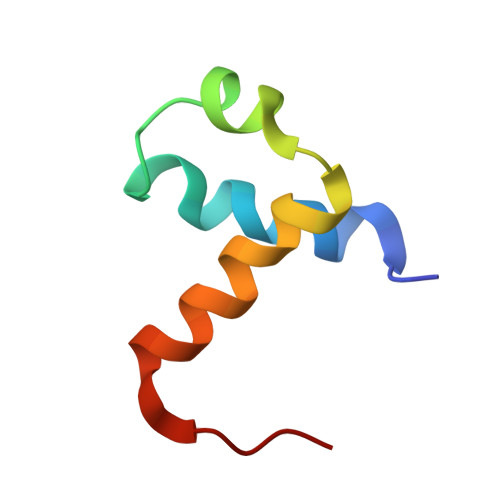The C-Terminal Domains of Vertebrate Cstf-64 and its Yeast Orthologue RNA15 Form a New Structure Critical for Mrna 3'-End Processing.
Qu, X., Perez-Canadillas, J.M., Agrawal, S., De Baecke, J., Cheng, H., Varani, G., Moore, C.(2007) J Biol Chem 282: 2101
- PubMed: 17116658
- DOI: https://doi.org/10.1074/jbc.M609981200
- Primary Citation of Related Structures:
2J8P - PubMed Abstract:
Yeast Rna15 and its vertebrate orthologue CstF-64 play critical roles in mRNA 3 '-end processing and in transcription termination downstream of poly(A) sites. These proteins contain N-terminal domains that recognize the poly(A) site, but little is known about their highly conserved C-terminal regions. Here we show by NMR that the C-terminal domains of CstF-64 and Rna15 fold into a three-helix bundle with an uncommon topological arrangement. The structure defines a cluster of evolutionary conserved yet exposed residues we show to be essential for the interaction between Pcf11 and Rna15. Furthermore, we demonstrate that this interaction is critical for the function of Rna15 in 3 '-end processing but dispensable for transcription termination. The C-terminal domain of the Rna15 homologue Pti1 contains critical sequence alterations within this region that are predicted to prevent Pcf11 interaction, providing an explanation for the distinct functions of these two closely related proteins in the 3 '-end formation of RNA polymerase II transcripts. These results define the role of the C-terminal half of Rna15 and provide insight into the network of protein/protein interactions responsible for assembly of the 3 '-end processing apparatus.
Organizational Affiliation:
Department of Molecular Microbiology, Tufts University School of Medicine and the Sackler Graduate School of Biomedical Sciences, Boston, Massachusetts 02111, USA.













